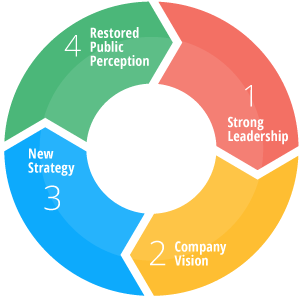
Over the past couple of years, there’ve been some serious PR blunders, leaving companies red-faced and scrambling to rebuild their image and win back the public’s trust. When a company faces a crisis, its CEO must step up and restore his or her organization’s PR image in a crisis.
Uber, Wells Fargo, and Facebook demonstrate how taking a hit from the press doesn’t necessarily mean disaster. Strong leadership and a carefully-crafted crisis communications strategy can help a company recover its image and earn back its audience’s trust. These examples will provide your team with strategies on how to communicate effectively and reboot your reputation in the public eye.
Wells Fargo
About a year-and-a-half ago investigators found 1.4 million fake Wells Fargo accounts after digging into the bank’s broken sales culture. The investigation escalated when it was discovered that up to 3.5 million fake bank and credit accounts had been falsely created by employees. Making matters worse, Wells Fargo found out that thousands of customers were also enrolled in online bill pay without their authorization. The company said its unrealistic sales goals for its employees encouraged unauthorized bill pay and new bank accounts.
In the wake of the scandal, Wells Fargo CEO Tim Sloan made a public statement: “We apologize to everyone who was harmed by unacceptable sales practices that occurred in our retail bank.” Going forward, the company attempted to right the wrong by scrapping its sales goals, installing new management and refunding millions to customers. When the bank recovered it made another public statement, saying that it was back in business, rolling out a TV campaign to try move past the scandal. The ad referenced the scandal, acknowledged past mistakes, and provided a clear message for the direction of the company moving forward.

Uber
There’ve been numerous PR scandals that have rocked Uber since 2014, many of them surrounding former CEO Travis Kalanick. One of the most notorious examples was when Kalanick was caught on camera arguing with his own Uber driver. The driver was complaining about the difficulty of making a living with the company’s declining rates, and Kalanick snapped into gear to defend those rates and demanded the driver to take responsibility for his problems and not blame them on anyone else. Only two months later Uber was in hot water once again after it was revealed that for the past two years, drivers were underpaid while Uber’s senior leadership took a large cut of the fares. A #DeleteUber social movement sprang from the public’s outrage at the company’s consistent run of bad behavior.
Following these very public PR disasters, Kalanick was forced to resign, and new CEO Dara Khosrowshahi launched a new series of commercials called “Moving Forward.” In this series Uber tried to show that the company is committed to making operational changes and how it treats its drivers and customers alike. Khosrowshahi also communicated to the public Uber’s new core values and is currently rebuilding its trust by committing to always do the right thing going forward. He even admitted if Uber ever falls short the company will always take responsibility for the problem and will fix it.

Just in this past year, it was revealed that dating back to 2015, Facebook was aware of consulting firm Cambridge Analytica, who worked on President Trump’s campaign, improperly accessing data from Facebook for 50 million of its users and selling it to the company. Cambridge Analytica’s goal was to manipulate voters’ opinions and send targeted, sponsored ads and messages to users on Facebook to swing their votes. By accessing Facebook’s data, Cambridge Analytica was able to see user’s interests, religion, political beliefs and activity, allowing them to specifically target these users. The scandal reached a breaking point when Congress called on Facebook CEO Mark Zuckerberg to testify.
How Facebook handled the situation baffled many. Given that Facebook was a pioneer in the tech industry, the world was shocked about how long the company stayed silent. If Facebook had immediately taken action and disclosed what it knew as soon as it became aware of the incident, it could have taken steps to protect user privacy and resolved the issue. This would’ve prevented outside interference, financial and reputational damage it’s currently undergoing. Since the company stayed silent, the incident spun out of control.

Being open and honest with your customers and audience whenever there is a change in the company that might affect them is the first step to staying on top of a disaster. Full transparency will guarantee you build trust and long lasting relationships with your customers. The worst thing a company can do is stay silent. If your primary function is to communicate the messages to your audience, there’s more to the role than communicating information about a product or service. You need to disclose everything happening with your company that might affect your customers. Even in a worst case scenario, being responsive and reacting quickly will ultimately allow you to minimize damage to your image and address consumer concerns quickly.
Until next time!
Critical Mention

Jolie Shapiro
Passionate about all things communications, Jolie found her dream job as a copywriter with Critical Mention, where she’s continuing her passion for writing and editing. With a background working for high-profile clients in the financial, hospitality and technology industries, she’s excited to bring her experience to Critical Mention. When she’s not writing you can find her at music festivals, hiking or snowboarding.









